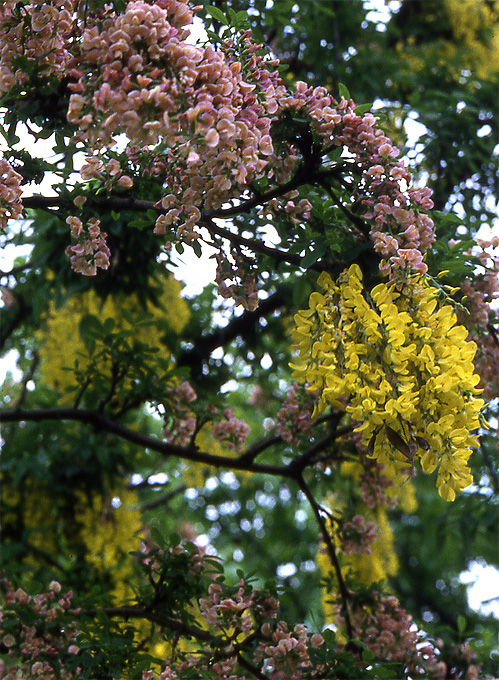- +Laburnocytisus 'Adamii'
Taxobox | name = +"Laburnocytisus"

image_caption = +"Laburnocytisus" 'Adamii' has flowers typical of both laburnum and broom
regnum =Plant ae
divisio = Magnoliophyta
classis = Magnoliopsida
ordo =Fabales
familia =Fabaceae
subfamilia =Faboideae orPapilionaceae
tribus =Genisteae
binomial = +"Laburnocytisus"
binomial_authority = ?+"Laburnocytisus" 'Adamii' (also known as Adam's laburnum or broom laburnum) is a horticultural curiosity; a small tree which is a
graft-chimaera between two species, alaburnum , "Laburnum anagyroides ", and a broom, "Chamaecytisus purpureus " (syn. "Cytisus purpureus"), which bears some shoots typical of the one species, some of the other, and some which are a peculiar mixture of both "parents".+"Laburnocytisus" 'Adamii' is a
legume , a member of the pea familyFaboideae (orPapilionaceae , formerlyLeguminosae ). Theplus sign (+) indicates its unusual origin. The plant can also be described by the formula "Chamaecytisus purpureus" + "Laburnum anagyroides". (It has also been known as +"Laburnocytisus adamii", as if it were one species, but strictly speaking it is not one species but two.) Only onecultivar , 'Adamii', is known to have arisen from this graft.Appearance
Most of the tree's branches resemble the laburnum in their foliage, which has three leaflets (3-palmate) and 3–6 cm long, yet also with dense clusters of broom-like shoots, also with three leaflets, but only 1 cm long and a darker green. It
flower s in late spring or early summer; some branches have long (20–30 cm)raceme s of yellow laburnum flowers, while others produce dense clusters of purple broom flowers. Remarkably, most branches will also produce coppery-pink flowers on short (8–15 cm) racemes, which are midway between the two "parents"; the leaves on these shoots are also intermediate. In older specimens, the proportion of broom and mixed tissues tends to decline, and the laburnum to predominate. The tree grows to a height of 7 m (rarely 8 m) and is hardy to USDA plant hardiness zone 5 in northernEurope . It requires moderately fertile, moist but well-drained soil and should be grown in a sunny position to flower well.Origin
The plant originated in the nursery of M. Adam near
Paris in 1825, probably as an accident; [ "Hillier's Manual of Trees & Shrubs" 5th Edition (1984) 164.] "Chamaecytisus purpureus" is normally a low-growing plant, andgrafting it onto a straight trunk of a related species would be expected to create an attractive, semi-weeping standard.In theory, other +"Laburnocytisus" could be developed in the same way but using different "parents"; a white-flowered broom might make a more attractive, if less striking, partner for the yellow laburnum.
tructure
A graft-chimaera is not a true hybrid but a mixture of cells, each with the
genotype of one of its "parents"; it is a chimaera, created by grafting, in which the tissue of one plant grows within an outer envelope of the second plant. In the case of +"Laburnocytisus" 'Adamii', laburnum forms the core, surrounded by the broom. [ "Hillier's Manual of Trees & Shrubs" 5th Edition (1984) 164.] Such plants are often called "graft hybrids", but as they are not true hybrids the use of this term is now discouraged.Other graft-chimaeras
+"Crataegomespilus" is a graft-chimera between hawthorn ("
Crataegus ") andmedlar ("Mespilus") which arose in a similar manner. There are two distinctcultivar s that have arisen from this graft: +"Crataegomespilus" 'Dardarii' and +"Crataegomespilus" 'Jules d'Asnieres'. [ "RHS Plant Finder 2006–2007" 20th Edition (2006) 202.]References
Wikimedia Foundation. 2010.
